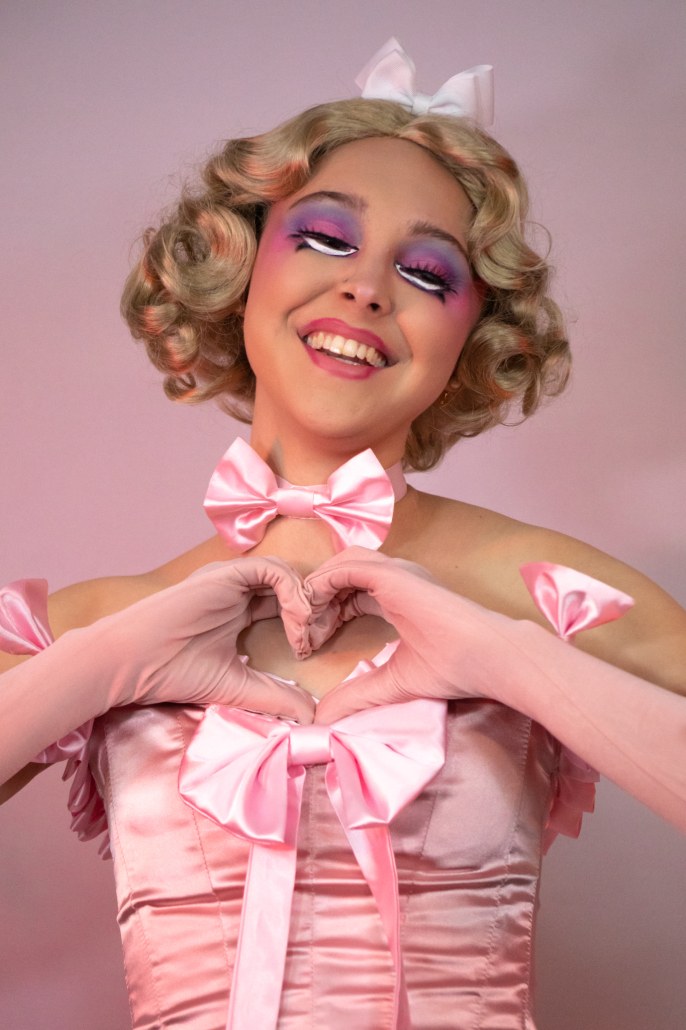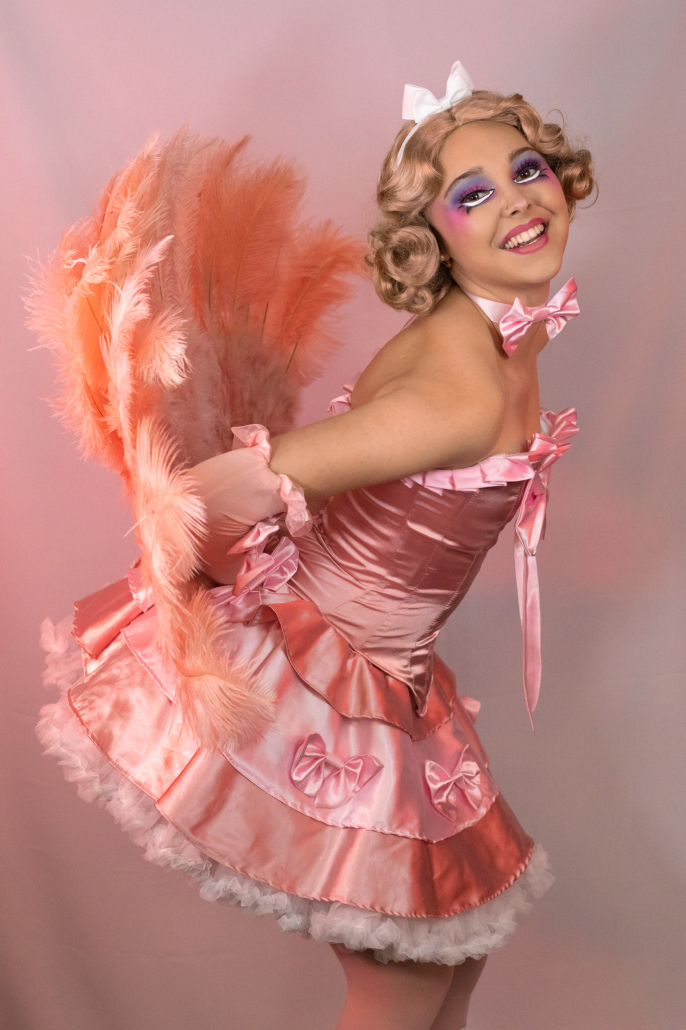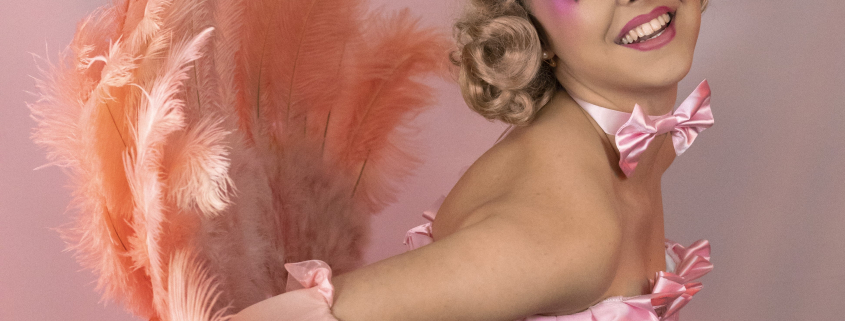Daisy Darling, in all her Gatsby glory

In the 1920s, there lived a grand dame. She was a beauty by trade and had charisma greatly coveted by gents, dames and royalty alike. Her name? Daisy Darling.
When this Darling came to be, every lacemaker shuddered from a sudden atmospheric change that foretold an era in which they would be working overtime to grace her delicate features. At that same moment, first-name-sharer Daisy Buchanan was found dead from the shock that she had been knocked from the post of being the world’s greatest Daisy. In my conversation with Hannah Gardiner, a junior studying English and East Asian languages and cultures, we spoke about her very vintage vantage.
Gardiner was a sophomore when she debuted the now-infamous Daisy, a grand whirlwind fantasy that drew on the feminine wiles of “Scooby Doo’s” Daphne and Wendy Darling from “Peter Pan.”
“The first time I ever performed was at Ground Zero,” Gardiner said. “My friend was with me and we were walking back from the gig. And he was like, ‘I’ve never seen you so happy.’ And it made me feel amazing. I’m a happy person in general, but it was a different level of being myself, like I’ve never been so authentically myself before.”
However, Daisy Darling had a different answer: “I’ve always been Daisy, darling, I just didn’t know before.”

Drag, by nature, has been an act of celebration and activism that is constantly stretched and recontextualized. For Gardiner, she felt a sense of freedom in this art form.
“I want to feel like a princess,” she said. “For me, total gender freedom is feeling hyperfeminine and feeling powerful … When I’m Daisy, I can explore my gender in a way that I don’t normally, because she’s so hyperfeminine. She caters to the female gaze instead of the male gaze.”
As drag reaches the mainstream, we’ve seen the political discourse and weaponization of anti-LGBTQIA+ sentiments reach the forefront of media. One of these instances is the various violent protests at “Drag Queen Storytimes” all across America, where false narratives have been created against drag performers. And yet, this “assault on gender norms” has brought life and joy into a community that has seen much persecution.
“Drag is not a threat to anyone. It’s a form of expression. It’s beautiful,” Gardiner said. “And if you feel threatened by drag, then you’re missing the whole point of what drag is … I would say drag queens show people that they can be authentically themselves. And kids deserve to see that too, they deserve to be able to think that they can be themselves in that same way.”
One of Daisy Darling’s drag sisters, Ra Oblivion, bore testimony to the journey Gardiner braved.
“Daisy is one of the most unique younger generation of drag queens that I’ve seen,” she said. “She has a clear vision and clear aesthetic that I admire … what I’d like to say to her is: trust your drag, trust your instincts, trust your gut [and] don’t doubt your work.”
For those who haven’t delved deep into the greater drag narrative, autistic assigned-female-at-birth queens like Daisy Darling are seldom and few. During her time as a drag queen, there were times where she had to take extra measures to ensure her slay stays that way. Even so, Gardiner feels as though being autistic has influenced her drag.
“A lot of autistic people, especially autistic AFAB [assigned-female-at-birth] people, have a heightened sense of imagination,” Gardiner said. “And I think that that’s really allowed me to unlock this persona that I’ve always had, but never knew how to channel before and drag was the conduit for that.”
In the simple act of owning her expression, Daisy Darling’s art could be seen as a quiet form of defiance in a heteronormative world. Drag’s thesis statement of inclusion isn’t just a tired syllabus copy-and-paste, nor is it an exclusive club. No, these queens are here to uplift.
“Anyone can do drag,” Gardiner declared. “We need more representation for AFAB queens and again representation for nonbinary kings and queens. And I think, especially, we want more representation for drag kings.”

As the “disabled drag doll of your dreams,” Daisy Darling is an angelic manifestation of Taylor Swift’s “Mastermind.” In addition to being an acclaimed queen in her own right, Gardiner has brought this femme fatale to life at a plethora of events around the Greater Los Angeles Area. This year, Daisy Darling is the executive director of the Queer and Ally Student Assembly’s 13th Annual Drag Show — one of the biggest collegiate drag shows in the country — which she has been planning since last June. Leading an enigmatic troupe of 14 incredible drag queens, Daisy Darling has quickly become a mentor in her own right.
“Daisy Darling is like a big sister to me,” said Will Yeaman, a freshman majoring in theatre, also known as Willconique. “Not only has she taken me under her wig and given me several drag opportunities, but she has actually reformed my idea of what drag is. Daisy, a cisgender female drag queen, exemplifies that drag is for everyone of any gender or sexuality. This community is not exclusive, and anyone who has respect for the art form should be welcomed and celebrated.”
The future of Daisy Darling is just beginning to bloom. Their profile continuously grows with each show they do. She’s new to the game. She’s autistic. She’s an AFAB queen. Most of all, Daisy Darling is here to stay, in all her magical mystique.
To bear witness to Daisy Darling’s magic and majesty with your mortal eyes, find the queen — along with a pantheon of drag performers — at the 13th Annual Drag Show this Saturday.
“You can look forward to a lot of stunts… and a stripteaser too,” Gardiner said. “[And] charisma, uniqueness, nerve and talent.”

